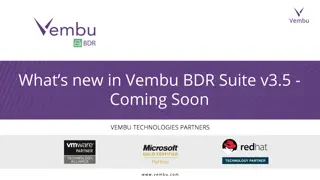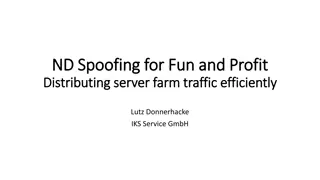Redundancy Masterclass: 8 Tricky Issues and How to Deal with Them
How to handle challenging aspects of redundancy, including employees on maternity leave, discriminatory selection criteria, targeting expensive employees, scoring adjustments for disabled employees, employee disputes, disabled employees at risk, and persuading the board.
0 views • 21 slides
Power Distribution in Data Centers Overview
Power distribution and equipment play crucial roles in commercial data center infrastructure, ensuring reliable and efficient operations. Adequate power routing from the grid or generators to data center equipment is vital for stable operations, data integrity, and performance maintenance. This incl
4 views • 19 slides
The Role of Artifacts and Evidence in Educator Evaluation and Support
Exploring the role of artifacts and evidence in educator evaluation, this content covers the three categories of evidence required by the Oregon Framework. It delves into the efficient process that reduces redundancy, essential components of SLG goals, and the types of evidence relevant to professio
0 views • 15 slides
Class 2 Permit Modification Request
This Permit Modification Request (PMR) aims to transition audit scheduling for site recertification from an annual to a graded approach, incorporating DOE Orders and Quality Assurance program requirements. The PMR consolidates scheduling information, reduces redundancy, and clarifies subsequent audi
3 views • 22 slides
Rationalization of statistical data exchange between national and international agencies
The discussion revolves around rationalizing statistical data exchange processes between national and international agencies, focusing on the challenges, principles, and proposed strategies to streamline reporting and dissemination. Key points include the complexity of data flows, burden of internat
1 views • 10 slides
Leveraging Affordable Technology for Addressing Staffing Challenges in Emergency Services
Discover how automated dispatch processes can help emergency service centers manage dispatcher workload, improve response times, and enhance situational awareness. Learn about the benefits of integrating affordable technology to streamline operations and ensure faster, safer alerting for fire statio
0 views • 14 slides
Introduction to Database Management System Explained
This presentation covers the basics of database management systems, including definitions of data, types of data, structured and unstructured data, storing data in computers using file systems and database systems, and issues with file systems like data redundancy, inconsistency, difficult data acce
1 views • 18 slides
Understanding Spread Spectrum Techniques in Data Transmission
Explore the concepts of bandwidth utilization, spreading, and transmission modes in data transmission and digital communication. Learn about spread spectrum techniques such as frequency hopping and direct sequence spread spectrum, which enable efficient sharing of wireless communication channels. Di
1 views • 28 slides
Understanding Database Systems in IT
Database systems play a crucial role in managing and organizing data efficiently. They provide a structured environment for storing and accessing information, enabling various applications in sectors like banking, airlines, universities, sales, and more. The transition from traditional file systems
3 views • 38 slides
Understanding Redundancy in the Workplace
This 3-day course on dealing with redundancy covers topics such as the definition of redundancy, employee rights, consultation processes, alternatives to redundancy, and more. Participants engage in activities to discuss tasks related to redundancy and explore the Employment Rights Act 1996. The cou
0 views • 15 slides
Understanding RAID Technology in DBMS: Redundancy and Performance
This content provides insights into RAID technology, discussing the combination of reliability and performance in managing multiple disks through various RAID levels like RAID 0, RAID 1, RAID 2, RAID 3, RAID 4, and RAID 5. It explores the advantages of RAID, such as data striping, mirroring, bit int
0 views • 61 slides
Update on Negotiated Rulemaking Committee (NRMC) Recommendations for Higher Education Data Requests
The update covers the proceedings and recommendations of the Negotiated Rulemaking Committee (NRMC) regarding data requests in higher education. The NRMC, formed under Texas Education Code, reviewed and proposed modifications to 93 data requests, aiming to streamline and optimize data collection pro
1 views • 24 slides
Global Relevance and Redundancy Optimization in Multi-label Feature Selection
The study focuses on optimizing multi-label feature selection by balancing global relevance and redundancy factors, aiming to enhance the efficiency and accuracy of data analysis. It delves into the challenges posed by information theoretical-based methods and offers insights on overcoming limitatio
0 views • 15 slides
Understanding Inheritance and Polymorphism in Python
Exploring the concept of inheritance in object-oriented programming, specifically in Python, to create a hierarchy of classes where subclasses inherit attributes and methods from a superclass. This approach helps to avoid redundancy and promotes code reusability. The relationship between superclasse
0 views • 11 slides
Understanding Fault-Tolerant Systems and Data Recovery Strategies
Explore the concepts of fault-tolerant systems, disaster recovery, high availability, and database technologies for ensuring the safety of information systems. Learn about uptime, downtime, MTBF, and MTTR, along with IBM's disaster recovery layers and solutions like redundancy, replication, and dive
1 views • 27 slides
Exciting Features in Vembu BDR Suite v3.5 - Latest Updates Revealed!
Discover the upcoming Vembu BDR Suite v3.5 features, including VMware failover & failback, IP & network remapping support, new releases like Vembu SaaSBackup and BDR360. Learn about Vembu's impressive background, founded in 2004, with a focus on serving over 60,000 businesses worldwide. Explore the
0 views • 31 slides
VF-Italy Network Requirements and Technical Limitations Overview
The document outlines the network requirements and technical constraints for VF-Italy's D-SIP, focusing on IMS network constraints, supported voice codecs, signaling protocols, and SIP access interfaces. It details the INVITE format for calls, codec requirements, DTMF support, signaling options, fai
0 views • 25 slides
Optimizing Ethernet Communication with PRP and HSR Redundancy Protocols
Explore how to optimize Ethernet communication using Parallel Redundancy Protocol (PRP) and High-availability Seamless Redundancy (HSR) protocols. PRP is ideal for connecting a large number of IEDs with the same application, while HSR is preferred for smaller networks with a single ring topology. Di
0 views • 23 slides
Cloud Load Balancing Overview and Requirements
This content provides a detailed overview of cloud-scale load balancing, involving components like servers, hypervisors, VMs, VIPs, DIPs, and the role of load balancers in distributing workloads efficiently. It also discusses communication flows involving VIPs, DIPs, front-end VMs, back-end VMs, and
0 views • 35 slides
Coping with Financial Crisis: Breaking Bad News and Preparing for Job Loss
This content explores the challenging aspects of financial crises, market crashes, mismanagement, job loss, recession, and bankruptcy. It delves into the repercussions such as redundancy, giving bad news, and the emotional turmoil involved in such situations. It provides insights on how to handle an
0 views • 5 slides
Low-Latency Inter-Datacenter State Machine Replication Using Clock-RSM
Clock-RSM introduces a low-latency approach to inter-datacenter state machine replication by utilizing loosely synchronized physical clocks. This method ensures strong consistency, fault tolerance, and fast failover in a geo-replication environment. By overlapping ordering and replication using phys
0 views • 29 slides
Review of Venus Flytrap Experiment Presentation
Investigate experimentally how Venus flytrap catches and digests prey. Reviewer Chris Kalemkeris analyzed the strengths and weaknesses of the presentation. Some key points include the lack of hypothesis, variables, and method details, as well as the absence of labeled pictures. The opponent highligh
0 views • 7 slides
Understanding Reed-Solomon Encoding: Basics and Applications
Messages consist of symbols from an alphabet and can face erasures and errors during transmission/storage. Redundancy is introduced in codewords to handle these faults, with schemes like 2x and 3x redundancy. Parity bits help detect/correct errors in binary messages efficiently, offering a cost-effe
0 views • 130 slides
Ohio Rail Grade Crossing Pilot Study Update August 2020
Ohio Rail Grade Crossing Pilot Study Update August 2020 provides insights into the methodology developed to evaluate rail-road grade crossings in Ohio, emphasizing adaptive capacity assessment tools and scoring. The study's objectives include assessing crossing importance, redundancy, and adaptabili
0 views • 12 slides
Procedural Decomposition and Static Methods in Programming
Understanding procedural decomposition and static methods is essential in programming to reduce redundancy, organize code effectively, and manage complexity. Procedural decomposition involves dividing a problem into methods, while static methods help in code reuse and managing complexity. By designi
0 views • 18 slides
Understanding Matching Keys in Database Systems
Matching keys play a crucial role in identifying the same real-world entities in database systems. They specify which attributes to compare and how to compare them, helping minimize redundancy and improve data accuracy. This summary discusses relative candidate keys, minimal matching keys, and relia
0 views • 13 slides
Improving Wireless Performance Through Content Overhearing Refactoring
Explore the concept of refactoring content overhearing to enhance wireless performance by focusing on throughput, leveraging overheard packets, suppressing duplicate data, and identifying sub-packet redundancy. Benefits of this approach include operating at finer granularity, redundancy elimination
0 views • 30 slides
Understanding VMware High Availability Deep Dive Concepts
Dive into the world of VMware High Availability with in-depth modules covering admission control policies, slot sizing, advanced settings, and failover capacity. Learn about cluster tolerance, slot reservations, resource fragmentation, and worst-case scenarios to optimize your virtual environment fo
0 views • 32 slides
Enhancing Erasure-Coded Storage with Repair Pipelining
Erasure coding is a powerful redundancy technique for distributed storage systems, offering fault tolerance and reduced redundancy compared to replication. This paper discusses the concept of erasure coding, its practical applications, and challenges such as repair penalties. It explores innovative
0 views • 21 slides
IP Fabric Architecture for GRNET Datacenters: Automating the Future
GRNET is expanding its data center infrastructure to address existing problems, balance tested and innovative solutions, and enable VLAN stretching between data centers. The new architecture aims to enhance network efficiency and scalability by implementing an IP Fabric solution. Previous architectu
0 views • 19 slides
Understanding Database Management Systems (DBMS): A Comprehensive Overview
This comprehensive overview of Database Management Systems (DBMS) covers the definition, environment, advantages, limitations, and characteristics of data in a database. It delves into the hardware and software components, user roles, and benefits of using a DBMS. The content highlights the control
0 views • 25 slides
Building Our Own Virtualized Infrastructure with Hyper-V
Learn how to set up a virtualized infrastructure using Hyper-V, including deploying Windows Server 2019, configuring Active Directory, setting up Failover Clustering, and managing Hyper-V Core servers. The guide covers network setup, domain controller promotion, clustering setups, iSCSI configuratio
0 views • 10 slides
Overview of Spacecraft Software Engineering Branch Activities
The Spacecraft Software Engineering Branch at NASA's Johnson Space Center (JSC) focuses on developing and implementing critical software for spacecraft systems. Their work includes utilizing the core Flight Executive (cFE) and Core Flight System (CFS) for various projects, such as the Morpheus lande
0 views • 10 slides
Lazy Code Motion and Partial Redundancy Elimination in Optimizing Compiler
Lazy code motion, partial redundancy elimination, common subexpression elimination, and loop invariant code motion are optimization techniques used in compilers to improve code efficiency by eliminating redundant computations and moving code blocks to optimize performance. These techniques aim to de
0 views • 35 slides
Revolutionizing Engagement Processes with OnPoint PCR
OnPoint PCR offers a smarter approach for preparing, compiling, and reviewing engagements, addressing challenges faced in adhering to professional standards and ensuring quality. By automating report drafting, providing guided methodologies, and centralizing document processes, firms find value in m
0 views • 5 slides
Understanding HITS: Connecting Data Centers, Applications, and Redundancy
Explore how HITS interconnects data centers, supported applications, and redundancy strategies in IT services. Learn about network diagrams, tier level requirements for data centers, supported applications by department, and the SAP ecosystem. Dive into concepts like redundancy versus non-redundancy
0 views • 8 slides
Understanding Active/Active SQL Clusters for High Availability
Discover the importance of Active/Active SQL clusters for ensuring 24/7 availability of your database servers. Learn about the benefits, setup process, and the high availability solution it offers for the entire server instance. Follow a detailed step-by-step guide for setting up SQL Active/Active c
0 views • 18 slides
Advanced HDFS Features in Distributed Computing
Explore the advanced features of Hadoop Distributed File System (HDFS) including Highly Available NameNode setup, HA NameNode Failover, ZooKeeper lock management, HDFS Federation benefits, and Federated NameNodes scalability beyond heap size. Learn about ensuring fault tolerance, performance, and sc
0 views • 37 slides
Low-Redundancy Proactive Fault Tolerance for Stream Machine Learning
This study focuses on enabling fault tolerance for stream machine learning through erasure coding. Fault tolerance is crucial in distributed environments due to worker failures, and existing approaches like reactive fault tolerance and proactive replication have drawbacks. The use of erasure coding
0 views • 20 slides
Network Design Challenges and Solutions
This content discusses various network design challenges such as high bandwidth servers, distributed clients, redundant communication setups, and proposes solutions like SDN implementation, HSRP for first hop redundancy, and ND for system rescue. It explores the implications of disrupting first hop
0 views • 9 slides







































